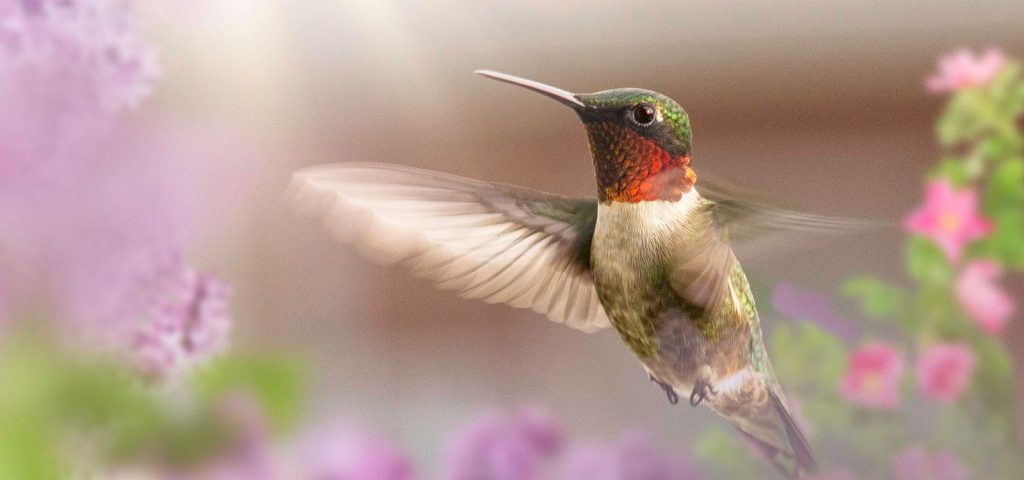Hummingbirds, fondly referred to as “hummers” among birders, are a type of small bird known for their incredible flying skills, including the ability to hover in mid-air due to the rapid flapping of their wings—up to 80 times a second in some species.
With over 350 recognized species, hummers display a remarkable variety of adaptations that allow them to thrive across a wide range of environments. This vast diversity in size, color and ecological niches makes hummingbirds a captivating subject for both scientific study and photography.
These images are from a recent hummingbird photo contest hosted and judged through community voting on Photocrowd.com. In a series of ten images—selected from a total of 483 entries—you will witness the breathtaking agility and vivid beauty of these tiny aviators.
Rufous Hummingbird (45th Place)
These are known for their incredible endurance and are long-distance migrants, traveling over 3,000 miles from their wintering grounds in Mexico to their breeding grounds in the Pacific Northwest and Alaska—one of the longest migrations of any hummingbird species relative to its body size.
Rufous hummingbirds are distinguished by their earthy, rufous (reddish-brown) coloring across the back and sides, with males showing a bright orange-red patch throat patch. The vivid colors and the detailed close-up in this photo show us the bird’s feathers and intense gaze.
Anna’s Hummingbird (41st Place)
Native to the west coast of North America, from Baja California to British Columbia, Anna’s hummingbirds have expanded their range over the past century, in part due to the proliferation of backyard feeders and the planting of flowering plants that they prefer. Unlike many other hummingbirds, these don’t strictly migrate but may shift locations to find favorable climates and food sources, demonstrating their ability to adapt.
In this image, you can see its tongue extended, a rare sight captured in exquisite detail. Hummingbird tongues work through a capillary action mechanism; when the bird inserts its tongue into a flower, the tongue’s tubular shape and the rapid movement facilitate the quick uptake of nectar. This action is so fast that it can be difficult to see in detail without high-speed photography.
Black-Chinned Hummingbird (11th Place)
This striking image features a Black-chinned Hummingbird, a species known for its agility and the distinctive black chin bordered by a thin strip of iridescent purple that can be seen in males. In this close-up shot, the hummingbird is elegantly captured in mid-hover as it feeds from a flower, a testament to its remarkable precision and speed. The intricate detail of its feather structure and the subtle interplay of light showcase the bird’s exquisite form and functionality.
Black-chinned Hummingbirds are common across the western United States and are particularly noted for their adaptability to different habitats, ranging from urban gardens to wild, mountainous landscapes. This photo not only highlights the bird’s graceful dynamics but also its crucial role in pollination, as it moves from one bloom to another, facilitating the reproductive cycle of plants.
White-Booted Racket-Tail (10th Place)
In this photograph, the birds are likely engaged in a territorial display, which involves rapid darting movements and showing off their striking tail feathers to intimidate rivals or attract mates.
The image illustrates the agility and vibrant coloration that hummingbirds are famous for, with their iridescent green bodies shimmering against a muted background, emphasizing the drama and speed of their aerial dance.
Brown Violetear (7th Place)
Known for its distinctive violet ear patches, the brown violetear is a medium-sized hummingbird native to Central and South America.
This tranquil pose allows us to appreciate the fine details of its plumage and the vivid violet ear patches that mark the species. It has strong territorial instincts and spends a lot of time guarding nectar sources from rival hummingbirds.
The photo illustrates another characteristic ability of many hummingbird species to hover motionlessly—with the exception of their very fast wings, of course. And because of the dark background, we are able to see the bird’s vibrant features, particularly its ear patch.
Antillean Crested Hummingbird (6th Place)
This species is primarily found in the Lesser Antilles and parts of the Greater Antilles, thriving in a variety of habitats from gardens to forests.
This image showcases the bird’s vibrant green plumage and the distinctive spiky crest from which it gets its name. The vivid red of the flower contrasts strikingly with the natural tones of the bird, highlighting its dynamic presence and the precise control it maintains even while hovering. This photo not only displays the beauty and grace of this hummer but also its vital role in pollination, helping to sustain the ecosystems it inhabits.
And, now, here are the three photos the Photocrowd community crowned as winners of the competition.
Green Hermit (3rd Place)
Characteristically larger than many other hummingbirds, the Green Hermit possesses a distinctive long tail and a primarily green plumage that can appear darker or lighter depending on the lighting. This species is typically found in the understory of lowland and montane forests across Central and South America, often seen flying along specific routes in search of flowers.
The species has a long, decurved bill perfectly adapted for accessing nectar from deep, tubular flowers like the vibrant one featured in this photo, which, incidentally, won third place by community vote in the competition.
Ruby-Throated Hummingbird (2nd Place)
The only species of hummingbird that typically nests east of the Mississippi River in North America, ruby-throated hummingbirds are known for the striking ruby-red throat patch (found in males), which can glisten like a jewel in the right lighting, this species exhibits a dazzling blend of agility and beauty, making it a favorite among birdwatchers and nature photographers.
They are known for their incredible migratory journeys, which often involves a non-stop flight over the Gulf of Mexico, a feat that demands immense endurance.
The Photocrowd community voted this photo the second best in the competition. It captures the exquisite detail and energy of the species in full flight, showing the bird’s shimmering green back and the ruby-red throat patch that gives the species its name, set against a vivid green background that accentuates the bird’s dynamic motion.
White-Throated Mountaingem (1st Place)
This is a species admired for its vivid coloration and agile flight. The image brilliantly captures the hummingbird’s poised motion as it hovers next to a bright red flower, its striking yellowish-orange and greenish-blue plumage contrasting beautifully against the buttery backdrop, drawing the viewer’s eye directly to the interaction between bird and bloom.
The white-throated mountaingem, found primarily in the highlands of Costa Rica and western Panama, is particularly noted for its distinctive white throat, which sets it apart from other hummingbirds. The species thrives in cool, misty forest environments where it frequents flowers like the one pictured.
Read the full article here






